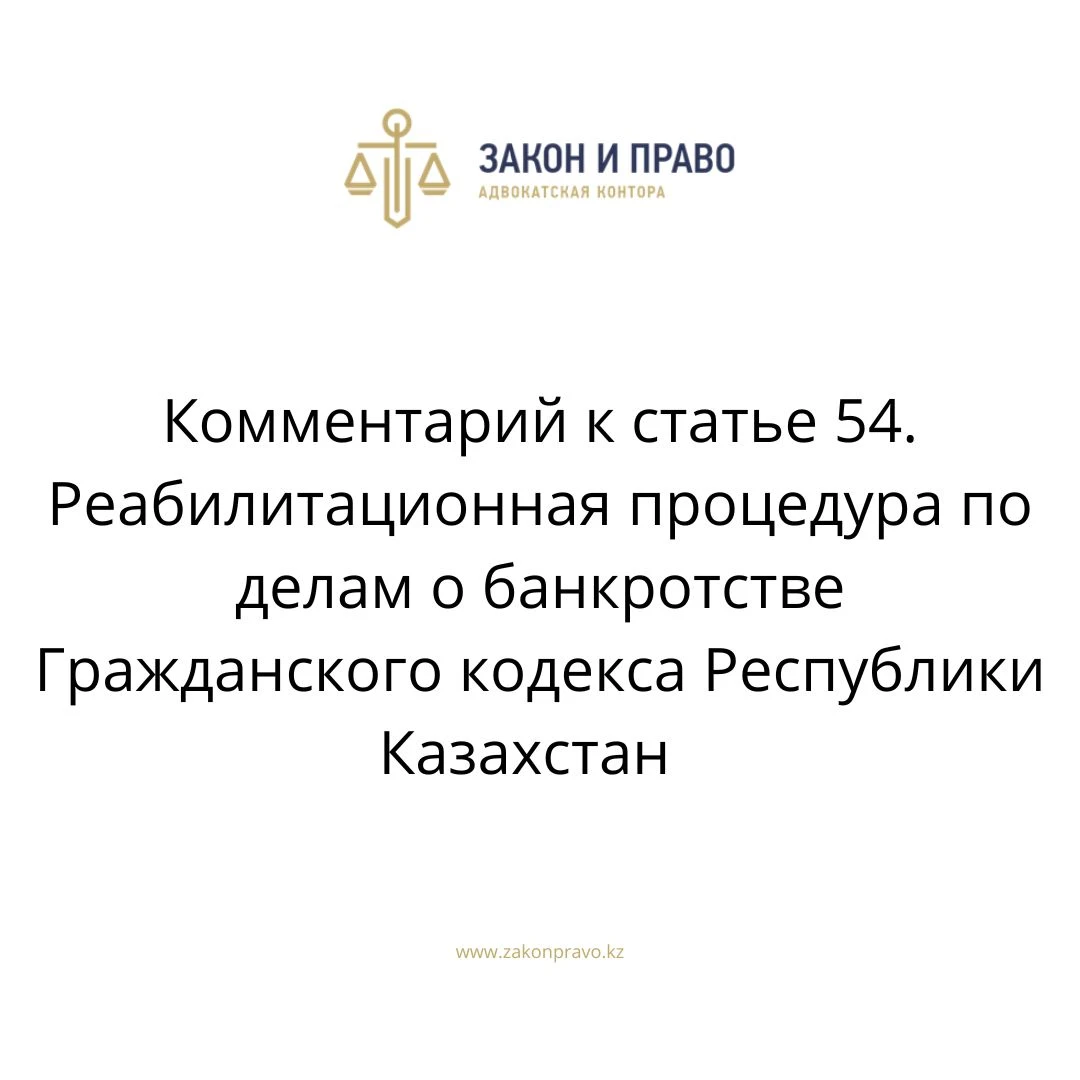Commentary to article 54. Rehabilitation procedure in bankruptcy cases of the Civil Code of the Republic of Kazakhstan
The procedure and terms of the rehabilitation procedure are determined by chapter 4 of the Bankruptcy Law.
The rehabilitation procedure can be applied only to legal entities - commercial organizations.
The insolvent debtor, the owner of the debtor's property (the body authorized by him), the creditor may file a petition to the court for the application of a rehabilitation procedure against the debtor before the court makes an appropriate decision.
A petition for the application of a rehabilitation procedure against the debtor may be contained in the debtor's or creditor's application for the initiation of bankruptcy proceedings.
The application must contain justifications for the expediency of applying the specified procedure to the debtor, the real possibility of restoring the debtor's solvency, and a proposal for the candidacy of a rehabilitation manager. The written consent of the candidate is attached to the application.
A rehabilitation plan for the insolvent debtor may be attached to the application for the rehabilitation procedure.
The financial statements for the last 2 years are attached to the application submitted by the debtor.
If there is a request to apply a rehabilitation procedure against the debtor, the court, with the consent of the secured creditors representing more than 50 percent of the total amount of secured claims, as well as bankruptcy creditors, which account for more than 50 percent of the total amount of claims of these creditors, submits to the candidate for rehabilitation managers a period of 30 to 60 days to develop a plan restoration of the debtor's solvency, except in cases when the rehabilitation plan is provided simultaneously with the application. For the specified period, the administration of the insolvent debtor is carried out by the administrator.
If collateral creditors representing more than 50 percent of the total amount of secured claims, as well as bankruptcy creditors accounting for more than 50 percent of the total amount of claims of these creditors agree with the proposed plan for restoring the debtor's solvency, and the interests of creditors who disagree with the debtor's rehabilitation plan are not infringed, the court approves the rehabilitation plan and makes a ruling on the suspension of bankruptcy proceedings and on the application of a rehabilitation procedure against the debtor.
The rehabilitation plan for an insolvent debtor should contain specific measures to restore the debtor's solvency (rehabilitation measures) and deadlines for repayment of debts owed to creditors.
Rehabilitation measures may include any organizational, economic, technical, financial, economic, legal and other measures that do not contradict the legislation aimed at preventing the liquidation of an insolvent debtor, as well as a set of such measures, in particular rehabilitation, assignment of the debtor's claims, and the conclusion of a settlement agreement.
The basis for applying a rehabilitation procedure to a debtor is the existence of a real possibility of restoring his solvency in order to prevent his liquidation. The real possibility of restoring the debtor's solvency is confirmed by relevant documents: contracts, calculations, economic justification, etc.
For the period of implementation of the rehabilitation procedure in relation to the debtor, a rehabilitation manager is appointed, to whom the powers of all bodies of the legal entity to manage its property and affairs are transferred. The rehabilitation manager is the trustee of a legal entity. The rehabilitation manager has the right to perform any actions that do not contradict the legislation aimed at achieving the goal of rehabilitating the debtor (dismiss employees, carry out internal reorganization, liquidate internal divisions, etc.).
Since the introduction of the rehabilitation procedure:
1) the claims of citizens to whom the debtor is responsible for causing harm to life or health are satisfied, with the exception of claims for compensation for moral damage;
2) settlements are made for the payment of severance payments and wages with persons working under an employment contract, and for the payment of remuneration under copyright agreements, the payment period of which came after the introduction of the rehabilitation procedure.;
3) taxes and other mandatory payments to the budget and extra-budgetary funds are paid, the deadline for which has come after the introduction of the rehabilitation procedure.;
4) creditors' claims arising from obligations, including from transactions concluded by the rehabilitation manager, the deadline for which came during the implementation of the rehabilitation procedure, are satisfied.
All other settlements on the debtor's debts to creditors, including debts that are recovered on writ of execution or in an undisputed manner, are carried out in accordance with the rehabilitation plan in accordance with the priority established by art. 75 of the Bankruptcy Law.
The rehabilitation manager is approved by the court. The debtor or creditors have the right to propose their candidacies for the rehabilitation manager.
With the consent of the collateral and bankruptcy creditors, who account for at least 2/3 of the total amount of claims, a legal entity may be appointed rehabilitation manager, if this does not contradict the objectives of its activities, which are clearly limited by legislative acts or constituent documents.
If there are several candidates, the rehabilitation manager is appointed on a competitive basis.
The duration of the rehabilitation procedure should not exceed two years. The court has the right, at the request of the rehabilitation manager, to extend the period of its implementation, but not more than 6 months.
The rehabilitation procedure is completed if its goal is achieved, if the goal cannot be achieved, if the actions of the manager harm the interests of the property owner and creditors.
Rehabilitation is possible as part of the rehabilitation procedure. Rehabilitation is a rehabilitation measure carried out in court or out of court, when the owner of the debtor's property (his authorized body), creditors or other persons provide financial assistance to the insolvent debtor, as well as implement another set of measures to mobilize the debtor's reserves and improve his financial and economic situation.
If the rehabilitation plan for an insolvent debtor includes rehabilitation as a rehabilitation measure, the plan must be accompanied by a written commitment from the rehabilitation participant to transfer funds to the debtor and/or creditors in accordance with the rehabilitation plan, indicating the amount and timing.
Constitution Law Code Standard Decree Order Decision Resolution Lawyer Almaty Lawyer Legal service Legal advice Civil Criminal Administrative cases Disputes Defense Arbitration Law Company Kazakhstan Law Firm Court Cases
The commentary was prepared within the framework of the scientific and practical research program of the Scientific Research Center of Private Law of the Kazakh State Law University.
Head of the working group on the preparation of the draft Civil Code of the Republic of Kazakhstan, Corresponding Member of the Academy of Sciences of the Republic of Kazakhstan, Professor Suleimenov M.K.
Deputy head Professor Basin Yu.G.


